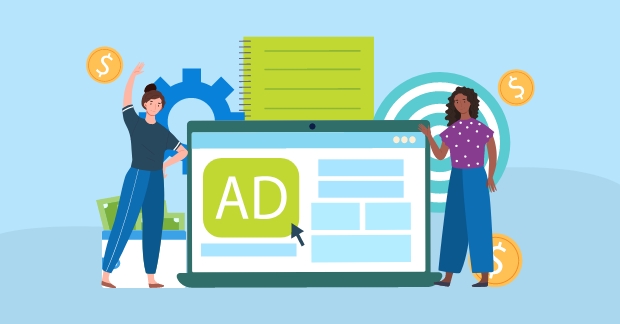If you talk to just about any tech marketer, they’ll probably tell you that their #1 goal for PPC is lead gen…aka getting visitors to fill out a form to give up the almighty email address.
In our most recent tech marketing survey—Paid Digital Advertising in the Real World—our respondents confirmed just that: 75% said they used paid digital advertising mostly for lead generation, while just one company was using this tactic primarily for brand awareness.
Interestingly, our survey also found that most tech companies (69% to be precise) feel that paid ads only produce okay-ish leads. Coincidence? We think not…and here’s why.
What’s wrong with using paid advertising only for lead gen?
The harsh truth is this: in order to get quality leads, you HAVE to nurture visitors starting at the top of the marketing funnel.
That means your CEO’s idea of running paid ad campaigns targeting brand-new prospects and expecting them to give up their email address after a single ad click can often be an unrealistic expectation. 😬
(Of course, your odds are better if you have a stellar landing page and can’t-miss content offer, but we digress…)
Have you heard of LinkedIn’s 95-5 rule? It posits that only 5% of prospects are in the market for your product at any given time. The other 95% of the time, they’re “out-market,” or not actively looking for a product solution.
While out-of-market prospects may still fill out a form on a landing page, they're less likely to do so than people who are actively researching a solution.
Therefore, if your paid advertising is focused only on lead gen, then you’re not marketing to the vast majority of potential prospects who aren’t quite ready to reach out or buy…yet.
How should you use paid advertising instead? (Spoiler: it’s brand awareness)
We know that tech companies want to see ROI ASAP, but here’s a reality check: if you’re okay with “meh” leads right away, keep running paid ad campaigns focused exclusively on lead gen.
But if you want quality leads down the road, start running paid ad campaigns focused on brand awareness.
By focusing on brand awareness, you can start to build an audience that recognizes your brand personality and authority, and will find your future communications to be valuable. That way, by the time prospects are ready to convert, they’ll be further down the funnel with a more positive impression of your company…every salesperson’s dream! 😁
While PPC is often used as a quick-win tactic, taking out paid ads for brand awareness takes time…so be patient. How long are we talking? According to Professor John Dawes of LinkedIn’s B2B Institute:
“It takes a long time. To appreciate the task, we need to have some understanding of how mental availability is measured. The progressive way to measure it is via the brand’s links to ‘category entry points’ or CEPs – in other words, various situations in which the category could be bought or used (see Romaniuk & Sharp, 2016 Ch. 4). The more people who link your brand to one or more of these CEPs is obviously better. But getting to double-digit figures for mental availability is a multi-year task. Many well-established brands achieve no higher than 20-30% of respondents linking them to a CEP. Even market leaders often only get 50%. This makes the task sounds difficult, and it is. It takes time, patience, funds and importantly, skill in making good media investments. But those businesses who can build mental availability in the minds of their potential buyers enjoy an enduring advantage, because competitors will find it very difficult to catch up.”
How can you measure the success of brand awareness paid campaigns?
Unlike lead gen PPC, which would be focused on form fills, brand awareness KPIs should be related to gaining exposure. This is why paid social channels are often (but not always!) better than traditional Google Ads.
Common brand awareness KPIs include:
- Reach (called impressions on Google Ads)
- Clicks or CTR
- Video views
- Engagement: likes, comments, shares
- Social page likes/follows
What types of paid ads are best for brand awareness?
Traditionally, paid digital advertising has been virtually synonymous with text ads on Google Search Network (aka those paid ads that show up on the first page of search results).
Now, however, we’re seeing B2B tech marketers using paid social tactics like sponsored posts/boosted content (81%) and in-feed ads (50%) as a part of their strategy. The good news? Those are great places to start your brand awareness efforts!
Looking for more advanced ideas?💡Here are some of our favorites:
- Set up retargeting ads on Google’s Display Network for continued brand exposure for people who have already visited your website or social media pages.
- On Facebook, try a more engaging format than a sponsored image post…perhaps a video or carousel ad. Something that will make people stop scrolling for even just a second or two.
- Ungate downloads to reduce bounce rates on landing pages and increase the number of people who will actually read your content. If you’re giving away white papers or webinars without requiring an email address, you’re in a great brand awareness mindset because you’re focused on building authority without generating immediate leads.
- If you want to stick with Google Search Network, change your bid model to “pay-per-impression” and position yourself as an expert in the field. For example, if you’re a cybersecurity company and there’s a big data breach in the news, bid on keywords related to that topic.
A successful PPC campaign that fosters lifelong customers, loyal fans—and yes, conversions—takes time but it’s well worth the investment…so you better get started!






